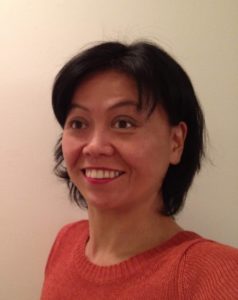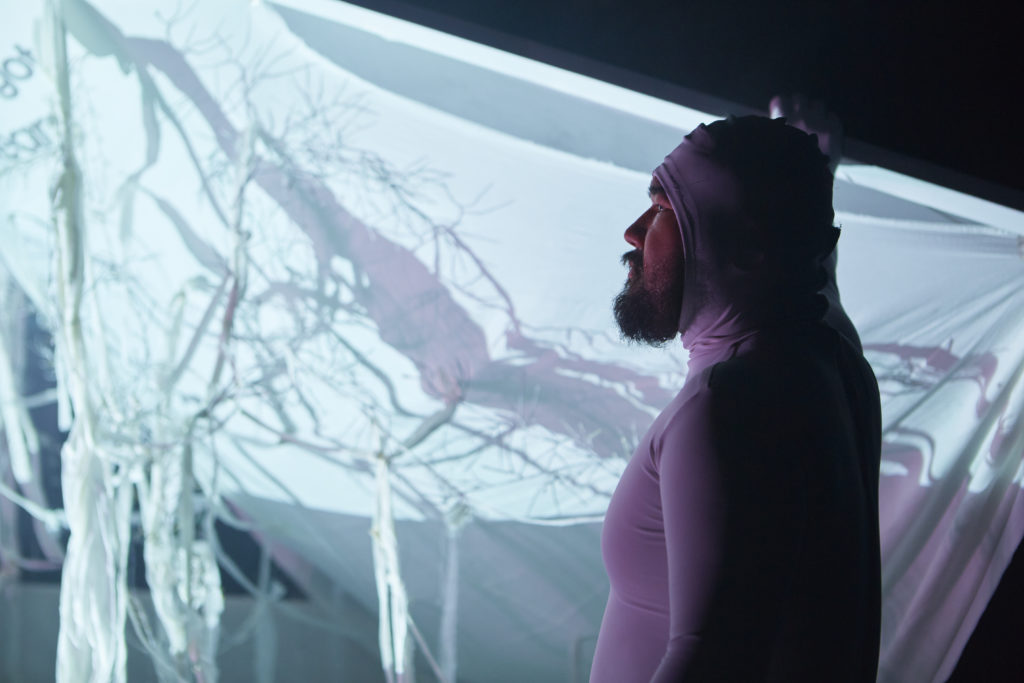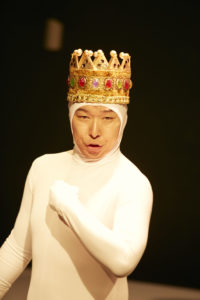Yoko Shioya is used to breaking language and cultural barriers. As artistic director of New York City’s Japan Society, she has been bringing Japanese theatre to the U.S. since 2003. Shioya, the first Japanese director of Japan Society’s performing arts program, curates a season of theatre, music, dance, and traditional Japanese performing arts every year, aiming to provide U.S. audiences with a unique theatrical experience of Japanese life and culture. She has even been awarded for her work, with the NY dance and performance community giving her a 2019 Bessie Presenter Award for Outstanding Curating.

In a recent interview, Shioya spoke about the typical structure of a Japanese theatre company and its recent shift from what she called a “mafia” system, as well as Japan Society’s upcoming production, a show from Theater Company Kaimaku Pennant Race (KPR) that merges Macbeth with Ashita no Joe, a popular boxing manga from the 1960s. The following are excerpts from our conversation.
CAITLYN HALVORSEN: Could you first tell me about how you curate a season here? It seems like there’s a healthy mix of traditional and contemporary forms, so I’m curious as to what your typical process is or your priorities are.
YOKO SHIOYA: Well, there’s no typical process, but we present roughly four genres, which are my way of dividing the performing arts: music, theatre, dance, and traditional performing arts. Our season runs from September through either May or June, so nine or eight months. It’s not really that we have to, but I think that we have to [Laughs]—really to cover everything each year. So then it’s just simple math: Each genre has two presentations a year. Just talking about music, it could be pop music, it could be Western classical music, contemporary music, or very avant-garde, improvisation-based music. Music has lots of sub-genres. So I said roughly four, but then still it’s a complication of which subgenre. I really try to have all aspects of the performing arts going on in Japan.
I also started the English-translated contemporary-play staged reading series 15 years ago, so that counts as theatre, and then we usually bring at least one theatre group [from Japan]. Most of the time we even produce a tour in North America. Actually, producing the tour, at least two projects per year, is something I have been constantly doing since I became a director here, which is already 15 years ago. [Makes a face; laughter.] So 15 years ago when I became director, I was the first Japanese director to lead the performing arts program in the history of Japan Society.
Oh, wow.
Japan Society started in 1907, and the performing arts program has had regular presentations even before this building was built in 1953, so for almost half a century of history since the performing arts program started here it had American [artistic] directors. I thought that theatre is not just about language; it’s lots of layers of understanding or observing theatre in the language or the text, so I thought that the theatre was the genre that I, as the first Japanese director, should really put my effort into researching, from under the radar to on the radar—everything. Whereas my predecessor more or less had some sources out in Japan, I really go in and directly observe. I’ve been living here since the mid ’80s, so I can tell which plays can resonate with New Yorkers. That’s what I carry as my own mission leading the performing arts program: theatre, contemporary theatre especially, is the [genre] I should—not really focus on but carefully [present]. As I mentioned a little earlier, I go to see, even very under-the-radar things, and the artists are always evolving. It is worthy to do so even if a young artist’s current work doesn’t meet my programming direction or criteria. Artists are always evolving. You never know, so I invest my time to keep watching them.
I should have said this earlier, but Japanese theatre companies are usually founded by Japanese playwrights/directors, which is quite different from this country. This country, there’s a bunch of playwrights, and a bunch of directors and there’s not many companies. SITI is one kind of rare company in that they usually work with the same actors over and over again, no matter the production. Company [in Japan] means the company that is working with the same actors, who are led by a playwright/director. Having said that, in the last maybe 10 years, it’s not really as rigid, but kind of come-and-go. But usually company still means always led by the playwright/director.
And they perform that playwright’s plays, for the most part?
Yeah, so the company is a vehicle for the playwright to materialize his work, to be performed on the stage in his own direction. That’s quite different from this country. So as a definition, when I say company, that means the company which is led by the director who is a playwright whose plays are written for that company. Let’s define it that way for this conversation.
So usually when I bring a company I have seen their work for at least a few years. Another thing is that Japanese playwrights/directors/companies create new work twice a year, or even three or four times a year. It’s so fast-paced, compared with this country. I go to Japan four, five times a year, so it is not rare that I see two new works from the same company in the same year. It doesn’t require 9 or 10 years. In just two years I may be able to see four or five new works. It is very busy. That doesn’t necessarily mean that their funding is lucrative or anything; it’s just that when you work with the same actors it’s easier to put them together. They could count on what kind of actors would be available for them. That might be the reason.
Sometimes I bring the same artist’s different works a few times. I know the body of work of the creator. It’s not like I went to see one interesting thing [and said], “Oh, why don’t you come here?” I have really spent lots of days and months and years getting to know what they are doing. Sorry, it’s a long, long answer to your first question…
No, it’s fine. It’s a complicated question, as I’m sure it’s a complicated process.
Yeah, I really have to be careful which company I bring. I don’t have as many opportunities as a local presenter, who can bring many people, like a work-in-progress or an emerging artist series or reading series. The [Under the Radar] festival, for example, also has a component of showing the work in progress. I can’t do that, so that’s part of the accountability that I feel—I really have to know the body of the work of the company.
So, since Japanese theatre has a much quicker process, do companies set up workshops or readings or anything, or do new works usually go right to a full production?
Usually, they go straight to production, except when the playwright/director has some opportunity of residency in this venue or in other countries. That sometimes happens.
What are some of the challenges of bringing a show from Japan to the U.S., both in terms of the technicalities of actually getting the company here but also audience expectations and how those might differ between Japan and the U.S.
Music and dance are not language-oriented art forms, so I would say the challenge belongs to the theatre. And I am not talking about the challenge of the translation or subtitles; I think I have enough expertise and good networks for the translation. But translation is just the final part of what we have to do. Before then it’s: The play is very funny but that funniness may not be really work for Americans, or, This play very much depicts what’s going on in Japanese society but there are too many references to TV commercials or the popular sweets. [Laughs] The play must be very Japanese, depicting the very core of Japanese society or urban life or the feelings of a young generation. But somehow it still must have a strong thread in it that can be shared with the same-generation Americans or the urban life experienced by New Yorkers and Tokyoans. So it has to work here, and when you are talking about theatre in this city, how many theatre productions are going on, everybody’s busy and theatregoers, they know what they what they like to see.
What I bring here is that no matter what, you can’t see this type of thing other than here. That is very, very important. I’m pretty sure that any nonprofit venue is very conscious of what their unique voices are, but the uniqueness is more important here probably, because if we just say “Japan” and then try attract the people who potentially have an interest in Japanese culture, it’s not enough for theatre.
The target [audience] for us is probably someone who wants to see things that they can’t predict. There are roughly two types of audiences: The audience that wants to see the things that they know, versus people who want to be surprised, who want to be…shocked. [Laughs] Our target is definitely the second one. For that reason, we don’t really bring work that is straightforward.
Could you talk about how the productions make it here, logistically and financially?
One Japanese private grantmaking foundation started to give money to contemporary theatre newcomers to go abroad. That grant actually got stopped, by now 10 years ago, but I somehow keep trying to do it. [Laughs] By asking the company to apply for a grant in Japan, from the Japanese government, they can fund themselves, so we do not have to really prepare all the money here. Especially when we produce a tour, usually the Japanese government grant can cover all the costs for the international or the domestic travel, most of the time even some of the hotel costs for the tour. It’s really important that they get the money from there.
And that’s a government grant?
It’s government.
Oh, wow. It’s nice to know that the government in Japan is helping fund artistic endeavors.
Yes, so I piggyback on that. [Laughs] Also the European government’s money for the arts is much, much, much larger and more generous than this country.

Japan Society’s mission is to “deepen the understanding between Japan and the U.S.” How would you say the performing arts works as a medium for this connection?
There’s many ways to answer the question. We are helped by a trend that is happening, not because of effort. Japan Society is having our 112th year, this is our 111th season. A long time ago people who were attracted to the culture of Japan liked traditional things, like the kimono, or the old wood block prints, or Fuji Mountain. Then in the ’80s, when the business aspect of Japan became very rich, many businesspeople started to learn Japanese, and then Japanese business customs, like how to give business cards or how to not shake hands but bow to each other. Recently—it’s already been two decades by now—but there’s manga, anime, the pop-culture thing, and pop culture’s power is enormous.
Theatregoers, especially the contemporary experimental theatregoers, are familiar with Toshiki Okada, of chelfitsch, and we are the ones who gave him his U.S. debut, now already 10 years ago. Toshiki is one of the biggest names in the international theatre world these days. We always try to be one or two steps ahead of everybody. If they say, “Well, I know Japan’s new thing,” then I say, “Yes, it might be new, but there are more new things this year.” That’s the continuation of bringing new things or deepening what you might think you already know. It is a very important thing for us to uphold, Japan Society-wide.
Something that might have a surface-level familiarity with a U.S. audience is used almost as a hook?
Yes.
Then, “Here’s all this other stuff about it that you might not know.”
Yeah, that’s right. Sometimes we try to drop the bomb. [Laughs]
How have you noticed Japanese theatre changing over the course of your career?
Ah, it may not be really seen from outside, but as I mentioned, company means the same actors are together. It has been quite strange these days. Aya Ogawa wrote or said that the old-time Japanese theatre company is like a mafia system. As an actor, as a performer, you have to be loyal to the “godfather,” and then in return you are always guaranteed to have a role on the stage. That mafia system is not really working these days.
Why do you think that is?
Maybe it’s just a generational thing. I mean it’s like business; businessmen in Japan, they had to be loyal to a company, which they started to work for right after college. And then the reward was a lifetime in that employment system. Japanese companies can no longer afford that system, and so accordingly the people’s sense of loyalty is different, it’s shifted and diminished. At the same time, that means there’s a sense of independence or individualism growing. It’s not really a “which is better and which is worse,” it’s more of a balance of pros and cons. What happened before, when the mafia system existed, sometimes playwrights had to say, “Oh, there’s no good role for him this time, but I have to have him on the stage, so why don’t I put this character as an addition?” That’s sacrificing of your own creation, right? It limits freedom; you have to put yourself in a kind of cage for that obligation. But these days playwrights don’t have that, so they do not have a guarantee of the actors as it used to be. And young people enjoy being by themselves: “I like to perform for this director, but then at the same time I want to perform for that director.” And at the same time, directors have more opportunity to look for some other new talent, which may inspire them in a different way, so it’s just changing.
Has Japanese theatre has become more globally focused in the past years?
I think so. For example, again, Toshiki Okada, before he first went out of Japan, he totally believed that his play couldn’t be communicated with non-Japanese speakers, because his way of writing lines was so unique. But I believed that his lines were totally the same as teenagers or young people in this country. He didn’t believe at all that he could go out of the country, but then I told him, “No, no, no, it can be translatable, definitely.” And then I told Aya Ogawa, who was a staff member here, and they had a great synergy and she translated [his work]. Now that even Okada’s language can be translated outside of Japanese, that’s really changed the norm of the the new generation—that no matter what, their work can be communicated with non-Japanese speakers.

Tell me a little bit about Ashita no Ma-Joe.
Ashita no Joe is the title of the comic book about boxing that really made a hit in late ’60s/early ’70s, and actually ma-Joe means “witch” so you know, Macbeth.
Oh, what? That’s so smart! [Laughs] Yeah, so it’s a pun. So then Yu Murai, the director/playwright and the company leader of Kaimaku Pennant Race, his inspiration is that in Ashita no Joe, the protagonist is a troubled teenager in inner-city Tokyo with the ambition to be a ranked boxer. The last scene is really still a debatable thing, because he was sitting in a corner of the ring and [he says,] “I am really becoming ash” and then [drops head]. That is the last scene, so does “ash” mean that he died? Nobody knows [laughs]. But his rise and fall and Macbeth’s rise and fall are kind of overlapping.
Murai actually had a performance here in NYC 10 years ago with the NY Fringe Festival; that production was called Romeo and Toliet. So there are a few other titles based on classics and puns. [Laughs]
From your perspective, what’s next for Japanese theatre? Are there any general trends or recent innovations in productions that you’ve seen in Japan that you’re excited for or hope to bring to the U.S.?
As a company, we haven’t really done this, but more and more female playwrights/directors are emerging. It’s a really new phenomenon, and that’s why we have focused on Japanese female playwrights during the reading series two years ago, this year, and the next year. As a production I have not really done work by a female playwright yet, but using our money to translate plays to English is another big investment, which we have been doing for last three years. That’s really the new thing and the new trend that is happening.
That’s exciting to hear about.
Especially in this era, right?
CORRECTION: An earlier version of this story stated that Yoko Shioya has been bringing Japanese theatre to the U.S. since 2006, when she became artistic director of Japan Society. She was already bringing Japanese artists to the U.S. in 2003, when she was the organization’s director of performing arts.


